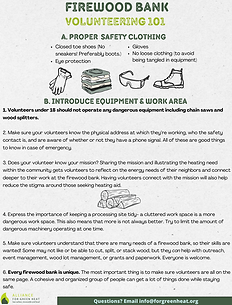
Firewood Bank Resources
Firewood Bank Resources Sheets
We welcome you to print out and distribute these resource sheets at your firewood bank. Click on the image and you'll receive a PDF download of the material.
If you have ideas for more materials, email info@forgreenheat.org!

Other Resources
Program Reports
Press Releases
Academic Resources on Firewood Banks
Wood Burning & Safety Resources
-
Firewood Bank Volunteer Task Information Form (from Montague Wood Bank)
-
Measuring Wood Moisture & Drying Time for Hardwood Tree Species
Past Firewood Bank Webinars/Videos
-
2025-2026 Firewood Bank Assistance Program Grant Info Session
-
Firewood Bank Financial Assistance Grant Information Session (2024)
-
Starting a Firewood Bank? Firewood Bank Models and Federal Financial Assistance (2023)
-
National Firewood Bank Summit Breakout: Wood Sourcing & Forest Health (2023)
Examples of Firewood Bank Initiatives
Firewood Banks in the News
Other Resources
Seasoned Firewood
Properly seasoned wood is key to a clean, efficient, and hot burn.
“Seasoning” is the process of drying firewood by splitting, stacking, covering, and storing it so as little moisture as possible remains trapped in the wood. The Environmental Protection Agency recommends only burning wood with a moisture content below 20%. See the EPA Burn Wise program page for more information and resources.
As a requirement of the wood deliveries undertaken by firewood banks supported by these federal grants, moisture content of wood must be taken and recorded for each delivery. This can be measured using a wood moisture meter.
Energy Audits & Weatherization
Weatherization programs, such as the Department of Energy’s Weatherization Assistance Program (WAP), provide valuable, free assistance to many low- and moderate-income households via energy efficiency upgrades, identified through an energy audit. These measures can include the replacement, cleaning, and repair of heating systems and safety testing for combustion appliances, among other mechanical and building shell improvements.
WAP is managed on a state-by-state basis, and typically participants must meet income eligibility guidelines in order to apply for weatherization services. More information for how to apply can be found on the DOE’s Weatherization Assistance Program website.

Firewood Banks Near You
Firewood banks operate all around the country. A 2016 report by Clarisse Hart, Director of Outreach & Education at Harvard Forest, identified 65 firewood banks in operation across the country. As of October 2025, we know there are at least 219 firewood banks in operation in the United States, with new firewood banks being discovered each month.
The map shows those first identified by Hart as brown circles while the red rhombuses indicate programs identified since 2022 in North America. The purple rhombuses represent firewood assistance programs outside of North America.
Wood Smoke, Health Impacts,
& Firewood Banks
Four key factors impact the amount of wood smoke around your home: (1) the type of wood burned (seasoned or not), (2.) the condition of wood stove used (EPA certified or not), (3.) whether the operator gives the stove enough air, and (4.) where the home is located (rural or urban, valley or ridge etc.). Check out our Firewood Community Safety Initiative to find out how you can be a part of the solution when it comes to wood burning health impacts. You can also watch our webinars on Common Problems – and Solutions – for Self-Installed Wood Stoves and Causes and Solutions to Indoor Smoke from Wood and Pellet Stoves to get more information about how one can reduce harmful wood smoke in the home.
Firewood banks should always be aware of potential public health problems from wood smoke and the steps they can take to reduce it. First, use your moisture meter to ensure wood that is being delivered is seasoned properly (20% moisture or less). Secondly, make sure to check with your local government or local air quality agency to see if there have been complaints about wood smoke or if there are laws restricting the burning of wood, or periodic “burn bans." Be aware that the geography of some areas, especially valleys or along large bodies of water, can make them particularly susceptible to air inversions (where warm air traps cold air underneath). Air inversions trap wood smoke at ground level and create a buildup of smoke that can harm health.
Firewood banks should also check to see if the households you are serving (i.e. low income) may be eligible for additional weatherization or energy assistance, such as insulation, wood (all
states subsidize wood fuel via LIHEAP), free repairs or even a new stove or heater, like a heat pump. Finally, make sure that your firewood bank is not supporting “nuisance burners” those who
produce excessive smoke that impacts neighbors. We recommend that firewood banks not provide wood to homes with old outdoor wood boilers since they are notoriously inefficient
and smoky.


.png)
.png)

.png)



